(AKC Terrier Group)
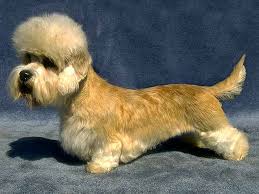 The Dandie Dinmont Terrier is characterized by his long, low body and
"scimitar" tail, which looks like a curved sword, as well as his large
soulful eyes and fluffy head of hair. Though small in stature, the
Dandie has the character of a big dog, possessing confidence,
intelligence and an independent nature. The breed’s allowable coat
colors are described as "pepper" and "mustard."
The Dandie Dinmont Terrier is characterized by his long, low body and
"scimitar" tail, which looks like a curved sword, as well as his large
soulful eyes and fluffy head of hair. Though small in stature, the
Dandie has the character of a big dog, possessing confidence,
intelligence and an independent nature. The breed’s allowable coat
colors are described as "pepper" and "mustard."
General Appearance
Originally bred to go to ground, the Dandie Dinmont Terrier is a long, low-stationed working terrier with a curved outline. The distinctive head with silken topknot is large but in proportion to the size of the dog. The dark eyes are large and round with a soft, wise expression. The sturdy, flexible body and scimitar shaped tail are covered with a rather crisp double coat, either mustard or pepper in color.
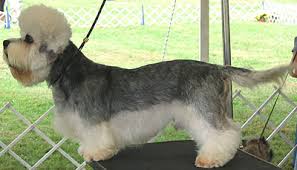 Size, Proportion, Substance
Size, Proportion, Substance
Height is from 8 to 11 inches at the top of the shoulders. Length from top of shoulders to root of tail is one to two inches less than twice the height. For a dog in good working condition, the preferred weight is from 18 to 24 pounds. Sturdily built with ample bone and well developed muscle, but without coarseness. The overall balance is more important than any single specification.
Head
The head is strongly made and large, but in proportion to the dog’s size. Muscles are well developed, especially those covering the foreface. The expression shows great determination, intelligence and dignity. The eyes are large, round, bright and full, but not protruding. They are set wide apart and low, and directly forward. Color, a rich dark hazel. Eye rims dark. The ears are set well back, wide apart and low on the skull, hanging close to the cheek, with a very slight projection at the fold. The shape is broad at the base, coming almost to a point. The front edge comes almost straight down from base to tip; the tapering is primarily on the back edge. The cartilage and skin of the ear are rather thin. The ear’s length is from three to four inches. The skull is broad between the ears, gradually tapering toward the eyes, and measures about the same from stop to occiput as it does from ear to ear. Forehead (brow) well domed. Stop well defined. The cheeks gradually taper from the ears toward the muzzle in the same proportion as the taper of the skull. The muzzle is deep and strong. In length, the proportions are a ratio of three (muzzle) to five (skull). The nose is moderately large and black or dark colored. The lips and inside of the mouth are black or dark colored. The teeth meet in a tight scissors bite. The teeth are very strong, especially the canines, which are an extraordinary size for a small dog. The canines mesh well with each other to give great holding and punishing power. The incisors in each jaw are evenly spaced and six in number.
Neck, Topline, Body
The neck is very muscular, well developed and strong, showing great power of resistance. It is well set into the shoulders and moderate in length. The topline is rather low at the shoulder, having a slight downward curve and a corresponding arch over the loins, with a very slight gradual drop from the top of the loins to the root of the tail. Both sides of the backbone well muscled. The outline is a continuous flow from the crest of the neck to the tip of the tail. The body is long, strong and flexible. Ribs are well sprung and well rounded. The chest is well developed and well let down between the forelegs. The underline reflects the curves of the topline. The tail is 8 to 10 inches in length, rather thick at the root, getting thicker for about four inches, then tapering off to a point. The set-on of the tail is a continuation of the very slight gradual drop over the croup. The tail is carried a little above the level of the body in a curve like a scimitar. Only when the dog is excited may the tip of the tail be aligned perpendicular to its root.
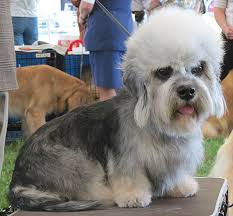 Forequarters
Forequarters
There should be sufficient layback of shoulder to allow good reach in front; angulation in balance with hindquarters. Upper arms nearly equal in length to the shoulder blades, elbows lying close to the ribs and capable of moving freely. The forelegs are short with good muscular development and ample bone, set wide apart. Feet point forward or very slightly outward. Pasterns nearly straight when viewed from the side. Bandy legs and fiddle front are objectionable.
Hindquarters
The hind legs are a little longer than the forelegs and are set rather wide apart, but not spread out in an unnatural manner. The upper and lower thighs are rounded and muscular and approximately the same length; stifles angulated, in balance with forequarters. The hocks are well let down and rear pasterns perpendicular to the ground.
Feet
The feet are round and well cushioned. Dewclaws preferably removed on forelegs. Rear feet are much smaller than the front feet and have no dewclaws. Nails strong and dark; nail color may vary according to the color of the dog. White nails are permissible. Flat feet are objectionable.
Coat
This is a very important point: The hair should be about two inches long; the body coat is a mixture of about 2/3 hardish hair with about 1/3 soft hair, giving a sort of crisp texture. The hard is not wiry. The body coat is shortened by plucking. The coat is termed pily or pencilled, the effect of the natural intermingling of the two types of hair. The hair on the underpart of the body is softer than on the top.
The head is covered with very soft, silky hair, the silkier the better. It should not be confined to a mere topknot but extends to cover the upper portion of the ears, including the fold, and frames the eyes. Starting about two inches from the tip, the ear has a thin feather of hair of nearly the same color and texture as the topknot, giving the ear the appearance of ending in a distinct point. The body of the ear is covered with short, soft, velvety hair. The hair on the muzzle is of the same texture as the foreleg feather. For presentation, the hair on the top of the muzzle is shortened. The hair behind the nose is naturally more sparse for about an inch.
The forelegs have a feather about two inches long, the same texture as the muzzle. The hind leg hair is of the same texture but has considerably less feather. The upper side of the tail is covered with crisper hair than that on the body. The underside has a softer feather about two inches long, gradually shorter as it nears the tip, shaped like a scimitar. Trimming for presentation is to appear entirely natural; exaggerated styling is objectionable.
Color
The color is pepper or mustard.
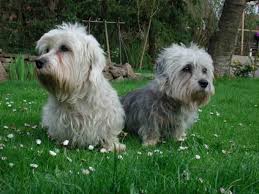 Pepper ranges from dark bluish black to a light silvery gray, the intermediate
shades preferred. The topknot and ear feather are silvery white, the lighter the
color the better. The hair on the legs and feet should be tan, varying according
to the body color from a rich tan to a very pale fawn.
Pepper ranges from dark bluish black to a light silvery gray, the intermediate
shades preferred. The topknot and ear feather are silvery white, the lighter the
color the better. The hair on the legs and feet should be tan, varying according
to the body color from a rich tan to a very pale fawn.
Mustard varies from a reddish brown to a pale fawn. The topknot and ear feather are a creamy white. The hair on the legs and feet should be a darker shade than the topknot.
In both colors the body color comes well down the shoulders and hips, gradually merging into the leg color. Hair on the underpart of the body is lighter in color than on the top. The hair on the muzzle (beard) is a little darker shade than the topknot. Ear color harmonizes with the body color. The upper side of the tail is a darker shade than the body color, while the underside of the tail is lighter, as the legs. Some white hair on the chest is common.
Gait
Proper movement requires a free and easy stride, reaching forward with the front legs and driving with evident force from the rear. The legs move in a straight plane from shoulder to pad and hip to pad. A stiff, stilted, hopping or weaving gait and lack of drive in the rear quarters are faults to be penalized.
Approved February 9, 1991
Effective March 27, 1991
Due to the breed's elongated body, there can be back issues within the breed specifically with intervertebral discs in the dog's backs. These discs can sometimes "slip" resulting in spinal disc herniation. Any symptoms relating to this can depend entirely on what part of the dog's back is affected, and can range to paralysis with loss of bladder and bowel control in the worst cases.
Following work by the breed clubs to ensure that any reoccurring health issues are dealt with, there are no especially common conditions affecting the Dandie Dinmont Terrier. However, minor issues affecting the breed can include hypothyroidism, primary closed angle glaucoma and Cushing's syndrome. In order to combat glaucoma in the breed, the breed clubs recommend that Dandies should have a procedure called a gonioscopy conducted on them at regular intervals throughout their lives. The Dandie is also at slightly higher risk of canine cancer than average. The average life expectancy of a Dandie Dinmont Terrier is 11–13 years.
 The breed is tough but usually friendly, and are suitable for older children.
It makes both a good companion and a guard dog, but are among the most
docile of the terrier breeds and are usually quite undemanding of their
owners. However they are known for their ability to dig large holes in a short space of time. They can be trained to be good with cats, but should not be trusted around smaller animals such as hamsters or rats.
They are described as being "very game", in that they are prone to
challenging other animals including foxes, and in some cases other dogs. Independent, determined, reserved and intelligent. The Dandie Dinmont Terrier
combines an affectionate and dignified nature with, in a working situation, tenacity
and boldness.
The breed is tough but usually friendly, and are suitable for older children.
It makes both a good companion and a guard dog, but are among the most
docile of the terrier breeds and are usually quite undemanding of their
owners. However they are known for their ability to dig large holes in a short space of time. They can be trained to be good with cats, but should not be trusted around smaller animals such as hamsters or rats.
They are described as being "very game", in that they are prone to
challenging other animals including foxes, and in some cases other dogs. Independent, determined, reserved and intelligent. The Dandie Dinmont Terrier
combines an affectionate and dignified nature with, in a working situation, tenacity
and boldness.
The Dandie Dinmont Terrier was bred from selected specimens of the rough native terrier of the Border hunters in the Cheviot Hills between England and Scotland and was first recorded as a distinct type of breed about 1700. He was distinguished by his preeminence in hunting the otter and the badger. A direct line of these dogs descended to the farmers in the Teviotdale Hills, where Sir Walter Scott in his travels chanced upon them and made them famous in his Guy Mannering, published in 1814. His character Dandie Dinmont, a farmer (believed to have been a Mr. James Davidson of Hindlee, near Hawick) kept the immortal six: "Auld Pepper," "Auld Mustard," "Young Pepper," "Young Mustard," "Little Pepper," and "Little Mustard." From the time of the popularity of Guy Mannering to the present day, the breed has been known as "Dandie Dinmont’s Terriers."
 Today the hunting qualities of the Dandie are not so often required,
but his other qualities make him an excellent house dog. He is
intelligent, fond of children, and an excellent guard. He has a will of
his own and will sometimes obey a command reluctantly, with a look of
"I’ll do it, but please don’t make me."
Today the hunting qualities of the Dandie are not so often required,
but his other qualities make him an excellent house dog. He is
intelligent, fond of children, and an excellent guard. He has a will of
his own and will sometimes obey a command reluctantly, with a look of
"I’ll do it, but please don’t make me."
Regular coat care is necessary for a Dandie. Frequent plucking will improve the texture and color of the coat. Only the longest hairs should be removed to keep the double coat and penciled appearance. If the coat is neglected for a long period, it may be necessary to strip it down close to the skin. This will leave only undercoat and the Dandie may appear white. It can take months for the coat to grow in to proper length and texture after stripping.
Dandies fit in anywhere, either in a rough-and-tumble out-of-doors life or in the confines of a city apartment. They are in ideal size, between 18 and 24 pounds, small enough to fit a small apartment and yet a dog big in character.
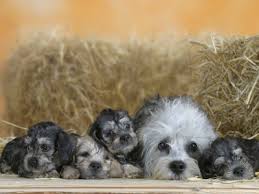
Dandie Dinmont AKC Terrier Breed Standards
General Appearance
Originally bred to go to ground, the Dandie Dinmont Terrier is a long, low-stationed working terrier with a curved outline. The distinctive head with silken topknot is large but in proportion to the size of the dog. The dark eyes are large and round with a soft, wise expression. The sturdy, flexible body and scimitar shaped tail are covered with a rather crisp double coat, either mustard or pepper in color.
Height is from 8 to 11 inches at the top of the shoulders. Length from top of shoulders to root of tail is one to two inches less than twice the height. For a dog in good working condition, the preferred weight is from 18 to 24 pounds. Sturdily built with ample bone and well developed muscle, but without coarseness. The overall balance is more important than any single specification.
Head
The head is strongly made and large, but in proportion to the dog’s size. Muscles are well developed, especially those covering the foreface. The expression shows great determination, intelligence and dignity. The eyes are large, round, bright and full, but not protruding. They are set wide apart and low, and directly forward. Color, a rich dark hazel. Eye rims dark. The ears are set well back, wide apart and low on the skull, hanging close to the cheek, with a very slight projection at the fold. The shape is broad at the base, coming almost to a point. The front edge comes almost straight down from base to tip; the tapering is primarily on the back edge. The cartilage and skin of the ear are rather thin. The ear’s length is from three to four inches. The skull is broad between the ears, gradually tapering toward the eyes, and measures about the same from stop to occiput as it does from ear to ear. Forehead (brow) well domed. Stop well defined. The cheeks gradually taper from the ears toward the muzzle in the same proportion as the taper of the skull. The muzzle is deep and strong. In length, the proportions are a ratio of three (muzzle) to five (skull). The nose is moderately large and black or dark colored. The lips and inside of the mouth are black or dark colored. The teeth meet in a tight scissors bite. The teeth are very strong, especially the canines, which are an extraordinary size for a small dog. The canines mesh well with each other to give great holding and punishing power. The incisors in each jaw are evenly spaced and six in number.
Neck, Topline, Body
The neck is very muscular, well developed and strong, showing great power of resistance. It is well set into the shoulders and moderate in length. The topline is rather low at the shoulder, having a slight downward curve and a corresponding arch over the loins, with a very slight gradual drop from the top of the loins to the root of the tail. Both sides of the backbone well muscled. The outline is a continuous flow from the crest of the neck to the tip of the tail. The body is long, strong and flexible. Ribs are well sprung and well rounded. The chest is well developed and well let down between the forelegs. The underline reflects the curves of the topline. The tail is 8 to 10 inches in length, rather thick at the root, getting thicker for about four inches, then tapering off to a point. The set-on of the tail is a continuation of the very slight gradual drop over the croup. The tail is carried a little above the level of the body in a curve like a scimitar. Only when the dog is excited may the tip of the tail be aligned perpendicular to its root.
There should be sufficient layback of shoulder to allow good reach in front; angulation in balance with hindquarters. Upper arms nearly equal in length to the shoulder blades, elbows lying close to the ribs and capable of moving freely. The forelegs are short with good muscular development and ample bone, set wide apart. Feet point forward or very slightly outward. Pasterns nearly straight when viewed from the side. Bandy legs and fiddle front are objectionable.
Hindquarters
The hind legs are a little longer than the forelegs and are set rather wide apart, but not spread out in an unnatural manner. The upper and lower thighs are rounded and muscular and approximately the same length; stifles angulated, in balance with forequarters. The hocks are well let down and rear pasterns perpendicular to the ground.
Feet
The feet are round and well cushioned. Dewclaws preferably removed on forelegs. Rear feet are much smaller than the front feet and have no dewclaws. Nails strong and dark; nail color may vary according to the color of the dog. White nails are permissible. Flat feet are objectionable.
Coat
This is a very important point: The hair should be about two inches long; the body coat is a mixture of about 2/3 hardish hair with about 1/3 soft hair, giving a sort of crisp texture. The hard is not wiry. The body coat is shortened by plucking. The coat is termed pily or pencilled, the effect of the natural intermingling of the two types of hair. The hair on the underpart of the body is softer than on the top.
The head is covered with very soft, silky hair, the silkier the better. It should not be confined to a mere topknot but extends to cover the upper portion of the ears, including the fold, and frames the eyes. Starting about two inches from the tip, the ear has a thin feather of hair of nearly the same color and texture as the topknot, giving the ear the appearance of ending in a distinct point. The body of the ear is covered with short, soft, velvety hair. The hair on the muzzle is of the same texture as the foreleg feather. For presentation, the hair on the top of the muzzle is shortened. The hair behind the nose is naturally more sparse for about an inch.
The forelegs have a feather about two inches long, the same texture as the muzzle. The hind leg hair is of the same texture but has considerably less feather. The upper side of the tail is covered with crisper hair than that on the body. The underside has a softer feather about two inches long, gradually shorter as it nears the tip, shaped like a scimitar. Trimming for presentation is to appear entirely natural; exaggerated styling is objectionable.
Color
The color is pepper or mustard.
Mustard varies from a reddish brown to a pale fawn. The topknot and ear feather are a creamy white. The hair on the legs and feet should be a darker shade than the topknot.
In both colors the body color comes well down the shoulders and hips, gradually merging into the leg color. Hair on the underpart of the body is lighter in color than on the top. The hair on the muzzle (beard) is a little darker shade than the topknot. Ear color harmonizes with the body color. The upper side of the tail is a darker shade than the body color, while the underside of the tail is lighter, as the legs. Some white hair on the chest is common.
Gait
Proper movement requires a free and easy stride, reaching forward with the front legs and driving with evident force from the rear. The legs move in a straight plane from shoulder to pad and hip to pad. A stiff, stilted, hopping or weaving gait and lack of drive in the rear quarters are faults to be penalized.
Approved February 9, 1991
Effective March 27, 1991
Dandie Dinmont Terrier Health Issues
Due to the breed's elongated body, there can be back issues within the breed specifically with intervertebral discs in the dog's backs. These discs can sometimes "slip" resulting in spinal disc herniation. Any symptoms relating to this can depend entirely on what part of the dog's back is affected, and can range to paralysis with loss of bladder and bowel control in the worst cases.
Following work by the breed clubs to ensure that any reoccurring health issues are dealt with, there are no especially common conditions affecting the Dandie Dinmont Terrier. However, minor issues affecting the breed can include hypothyroidism, primary closed angle glaucoma and Cushing's syndrome. In order to combat glaucoma in the breed, the breed clubs recommend that Dandies should have a procedure called a gonioscopy conducted on them at regular intervals throughout their lives. The Dandie is also at slightly higher risk of canine cancer than average. The average life expectancy of a Dandie Dinmont Terrier is 11–13 years.
Dandie Dinmont Temperament
Did You Know?
- Dandie Dinmonts were first recorded as a distinct breed around 1700.
- This breed was at one time popular with gypsies, but has also been a favorite of the very rich.
- Queen Victoria owned and loved a Dandie.
- The Dandie Dinmont is intelligent, fond of children, and an excellent guard.
- The breed got its name from a funny character in a book written in 1814 by Sir Walter Scott. The character’s name was Dandie Dinmont.
- The standard for the Dandie Dinmont Terrier was written in Melrose, Scotland in 1876.
Dandie Dinmont History
The Dandie Dinmont Terrier was bred from selected specimens of the rough native terrier of the Border hunters in the Cheviot Hills between England and Scotland and was first recorded as a distinct type of breed about 1700. He was distinguished by his preeminence in hunting the otter and the badger. A direct line of these dogs descended to the farmers in the Teviotdale Hills, where Sir Walter Scott in his travels chanced upon them and made them famous in his Guy Mannering, published in 1814. His character Dandie Dinmont, a farmer (believed to have been a Mr. James Davidson of Hindlee, near Hawick) kept the immortal six: "Auld Pepper," "Auld Mustard," "Young Pepper," "Young Mustard," "Little Pepper," and "Little Mustard." From the time of the popularity of Guy Mannering to the present day, the breed has been known as "Dandie Dinmont’s Terriers."
Regular coat care is necessary for a Dandie. Frequent plucking will improve the texture and color of the coat. Only the longest hairs should be removed to keep the double coat and penciled appearance. If the coat is neglected for a long period, it may be necessary to strip it down close to the skin. This will leave only undercoat and the Dandie may appear white. It can take months for the coat to grow in to proper length and texture after stripping.
Dandies fit in anywhere, either in a rough-and-tumble out-of-doors life or in the confines of a city apartment. They are in ideal size, between 18 and 24 pounds, small enough to fit a small apartment and yet a dog big in character.
Dandie Dinmont Pics
Dandie Dinmont Terrier
Parent Club: Dandie Dinmont Terrier Club of America, Inc.
Breeder Referral: Janette Shorrock, 3453 Fairwood, Lambertville, MI 48144, 734-854-3511
Parent Club: Dandie Dinmont Terrier Club of America, Inc.
Breeder Referral: Janette Shorrock, 3453 Fairwood, Lambertville, MI 48144, 734-854-3511
I havent any word to value this post.....Really i am inspired from this post....the individual who make this post it was an extraordinary human..thanks for imparted this to us. he has a good point
ReplyDelete